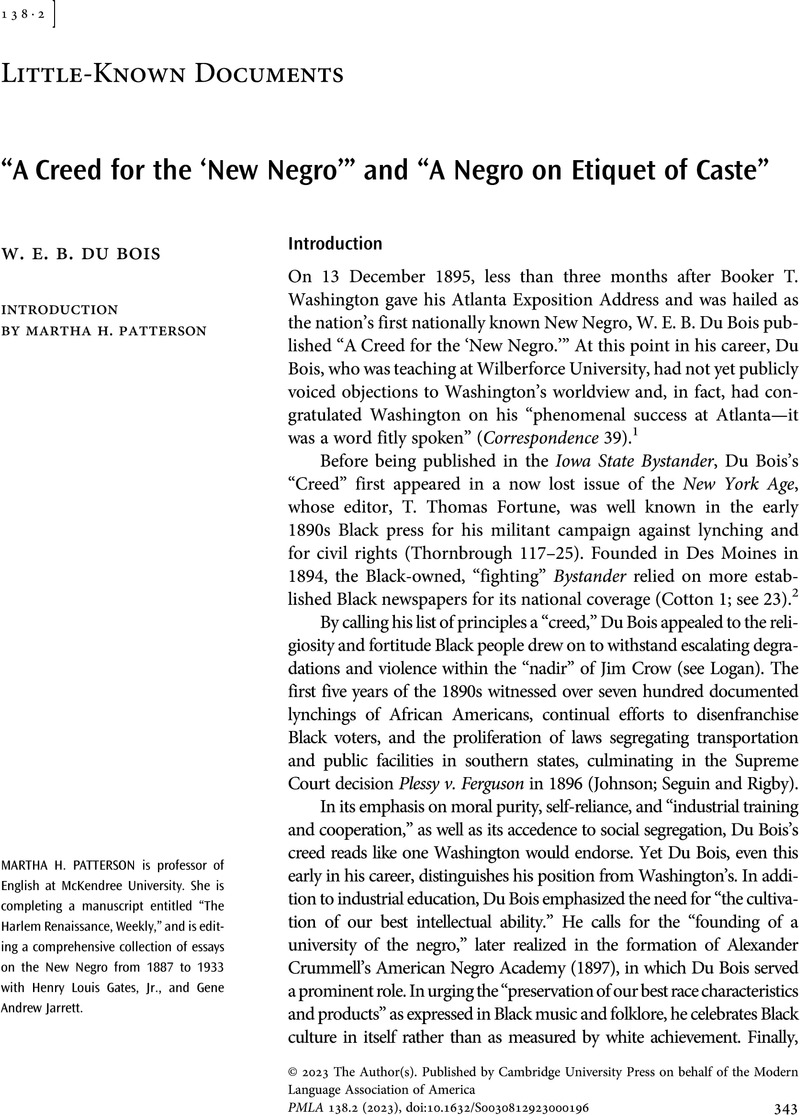No CrossRef data available.
Article contents
“A Creed for the ‘New Negro’” and “A Negro on Etiquet of Caste”
Published online by Cambridge University Press: 16 May 2023
Abstract
An abstract is not available for this content so a preview has been provided. Please use the Get access link above for information on how to access this content.

- Type
- Little-Known Documents
- Information
- Copyright
- Copyright © 2023 The Author(s). Published by Cambridge University Press on behalf of the Modern Language Association of America
References
Works Cited
Appiah, Anthony. “Ethics in a World of Strangers: W. E. B. Du Bois and the Spirit of Cosmopolitanism.” Justice, Governance, Cosmopolitanism, and the Politics of Difference: Reconfigurations in a Transnational World, Präsident der Humboldt-Universität zu Berlin, 2007, pp. 15–43. Humboldt-Universität zu Berlin, edoc.hu-berlin.de/bitstream/handle/18452/2372/vorlesung_appiah_kwame_ethics.pdf.Google Scholar
Appiah, Anthony. “The Uncompleted Argument: Du Bois and the Illusion of Race.” Critical Inquiry, vol. 12, no. 1, autumn 1985, pp. 21–37.CrossRefGoogle Scholar
“At a Meeting in New York . . . .” Iowa State Bystander, 13 Dec. 1895, p. 1.Google Scholar
Cotton, Sally Steves. The Iowa State Bystander: A History of the First Twenty-Five Years. 1983. Iowa State U, MS thesis.Google Scholar
Du Bois, W. E. B. “The Conservation of Races.” 1897. Project Gutenberg, www.gutenberg.org/cache/epub/31254/pg31254-images.html.Google Scholar
Du Bois, W. E. B. The Correspondence of W. E. B. Du Bois: Volume I, Selections, 1877–1934. Edited by Aptheker, Herbert, U of Massachusetts P, 1973.Google Scholar
Du Bois, W. E. B. “A Creed for the ‘New Negro.’” Iowa State Bystander, 13 Dec. 1895, p. 1.Google Scholar
Du Bois, W. E. B. “A Negro on Etiquet of Caste.” Iowa State Bystander, 13 Dec. 1895, p. 1.Google Scholar
Harlan, John Marshall. Dissenting opinion in Plessy v. Ferguson. “Plessy v. Ferguson (1896),” National Archives, www.archives.gov/milestone-documents/plessy-v-ferguson.Google Scholar
Higginbotham, Evelyn Brooks. Righteous Discontent: The Women's Movement in the Black Baptist Church, 1880–1920. Harvard UP, 1993.Google Scholar
Johnson, C. W. “Lynching Information.” Tuskegee University Archives Repository, 16 Nov. 2020, archive.tuskegee.edu/repository/digital-collection/lynching-information/.Google Scholar
Logan, Rayford Whittingham. The Negro in American Life and Thought: The Nadir, 1877–1901. Dial Press, 1954.Google Scholar
Seguin, Charles, and Rigby, David. “National Crimes: A New National Data Set of Lynchings in the United States, 1883 to 1941.” Socius, 6 May 2019, https://doi.org/10.1177/2378023119841780.CrossRefGoogle Scholar


